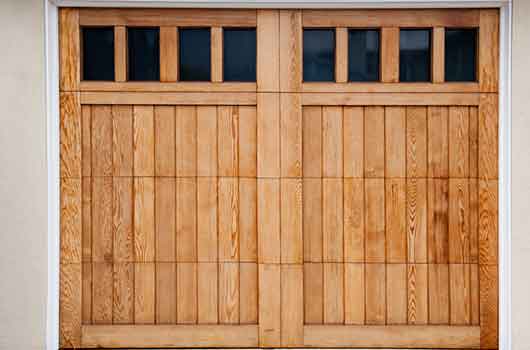How to protect your garage from extreme temperatures
 Does your garage do more than serve as a storage place for your car? If your garage doubles as a workshop, office, or game room, then it’s important to have an insulated garage door. When you insulate your garage properly, you’ll achieve maximized thermal efficiency with optimized reduction of air infiltration. That way, in any temperature, a well-insulated garage will give you a viable space all year, keeping you fully comfortable. You’ll keep as much cold out as possible during winter, and as much heat out as possible during summer.
Does your garage do more than serve as a storage place for your car? If your garage doubles as a workshop, office, or game room, then it’s important to have an insulated garage door. When you insulate your garage properly, you’ll achieve maximized thermal efficiency with optimized reduction of air infiltration. That way, in any temperature, a well-insulated garage will give you a viable space all year, keeping you fully comfortable. You’ll keep as much cold out as possible during winter, and as much heat out as possible during summer.
Protection in Cold Weather
Even if the temperature were to drop below freezing, when your garage is winterized, you’ll save a lot of money and time.
Insulate the garage walls. Proper installation of insulation in your garage requires that you closely study the installation guide. Be sure to choose the right insulation thickness for the walls of your garage. Typical mistakes people make are: not fastening the batt insulation securely; cutting it too short or too long for the location; or not properly supporting it. Keep in mind that the insulation must fit snugly; nevertheless, don’t jam it in too tightly.
Insulate the garage door. A large variety of products is available to you for insulating the garage door, including a specifically designed kit to do so. Effective insulation options include foam board, reflective barriers, and Fiberglass batt insulation.
No matter which option you choose, first you’ll have to cut the insulation to fill your garage door panels. Next, secure them with adhesive, each piece firmly in place. If your garage door doesn’t have recessed panels, the job will be easier.
For most folks, the prospect of insulating the garage by yourself is too overwhelming. If it’s all too much, then hire a dependable professional to install a modern-designed insulated garage door for you.
Insulate the entire garage. If your garage ever becomes too cold, it can damage not only your car, but also anything else you have in storage. Are your washing machine and dryer kept in the garage? If your washer still has water left in the pump or lines, it can freeze and crack. The same risk is possible with your vehicle’s fuel gels, which can freeze in the combustion engine. Another possibility that can arise is that paint can separate and become ruined during prolonged periods of freezing temperatures.
Repair or replace your weatherstripping. Weatherstripping will create an effective seal between your garage door opening and the garage door. If you notice any cold draft leaking into the garage between the garage door frame and the garage door, then take away any of the existing weatherstripping if you see that it is cracked or brittle. Scrape off any sealant that remains, using a putty knife and pry bar or flat scraper. Make sure the surface is as clean and even as possible. After you remove the old weatherstripping completely, then measure correctly in order to apply the new weatherstripping. To align it, close the garage door and make sure the rubber flap slightly flattens against it. You will have an effective seal and the garage door will operate smoothly.
Install a unit heater in the garage. Weatherstripping and insulation will keep your garage protected from extremely cold temperatures in winter weather, but if you’d like to be extra warm, then add a unit heater. (On the other hand, if you’re located where your winters are mild, then an electric unit heater is probably all you’ll need, since you’ll need heat only once in a great while.) You can heat your garage with minimal construction costs and space requirements. Overall, gas-fired units are normally cheaper to operate, but they’re more difficult to install since they require a gas supply and exhaust venting. There’s also the electric model, which is easier to install yet more expensive to manage. A particularly efficient electric option is the mini-split heat pump, which provides efficient cooling and heating for your garage with a mere 3″ hole through an outside wall.
Protection in Hot Weather
During summer, your main objective is to enhance the airflow throughout the garage. Taking even just one of these measures is definitely worth considering:
Insulate the garage ceiling. If you use paper-backed batt insulation, ceiling wallboard isn’t needed. Install the insulation with staples, paper side down, or put the insulation in place using netting. You can also apply staples to fasten the netting. Professional garage door technicians advise you to do both.
Plant a tree close by. A hardwood or deciduous tree is an aesthetic and economical way to cool your garage down during summer. (And, it even keeps your garage warm during winter.) Plant the tree between the garage and the position of the sun in the warmest part of the day. The leaves will provide shade. (In winter, the bare branches will allow sunlight to come through, providing warmth.)
Leave the garage door open slightly, about a foot from the ground, and add a fan, too.
Wall insulation keeps out summer heat with desirable efficiency. Use wallboard or other paneling to encapsulate the material. You’ll prevent pets, toddlers, and teenagers from tearing things out.
Install a stationary vent on the roof. This is an inexpensive way to create an exit point for hot air that gets trapped in the garage’s attic. Or, if your budget allows it, install a mechanical exhaust system. Fans will draw cooler air from the garage into the attic. This will cool down the attic as well as the space below.
Insulate the garage overhead door. For a metal garage door, add a layer of rigid insulation that’s 2″ thick, attached to the inside of each panel with contact cement. Or, an insulated sectional overhead door is a superior alternative.
Attach an adjustable rollaway awning onto the garage’s sunny side. The shade will cool things off during the summer.
Garage Door Articles
- Upgrades to Increase Value
- How to Clean a Pre-Finished Steel Door
- Troubleshooting Garage Door Openers
- Garage Door Opens or Closes on It's Own
- Garage Door Spring System vs Pulley System
- How to make your garage door last as long as possible
- How to find a good garage door service
- Garage door Maintenance
- Check these things when your garage door is not working
- How to protect your garage from extreme temperatures
- Sectional garage door or solid garage door advantages and disadvantages
- Garage door safety tips
- Are you having garage door troubles here's what to do
- Fees associated with installing a new garage door
- Garage door wont open or close with remote
- Best Way to Clean Wood Garage Door
- Identifying Garage Door Spring Issues








